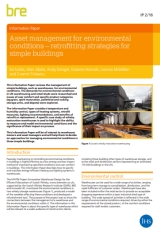Asset management for environmental conditions - retrofitting strategies for simple buildings
BRE (Building Research Establishment) is an independent, research-based consultancy, testing and training organisation, operating in the built environment and associated industries.
Asset management for environmental conditions - retrofitting strategies for simple buildings (IP2/16) was written by Ed Suttie et al, and published by BRE on 6 May 2016.
Passively maintaining or controlling environmental conditions in buildings is highly effective as a low energy and low impact method of maintaining specified conditions and user comfort. This 12- page Information Paper describes how to specify and maintain energy-efficient heating and lighting systems in simple buildings, such as warehouses.
The MATIN Project (Innovative Warehouse Design for the Efficient Maturation of Scotch Whisky), monitored the environmental conditions in two whisky storage warehouses, produced a model of the variables affecting these conditions and developed a refurbishment tool. The purpose of the project was to show the connections between the management of a warehouse and the environmental conditions within it. The demands for environmental conditions in UK warehousing and retail sheds were researched and issues of user comfort and specific product categories (eg grain, spirit maturation, palletised and racking storage units, and depots) were explored.
This Information Paper provides guidance about this specific type of warehouse which will be relevant to a wider audience of construction clients, including those building other types of warehouse storage, and to the retail and distribution sectors. It will help them to decide on approaches for managing environmental conditions in these simple buildings.
It considers temperature and humidity control, types of heating systems, retrofit measures, lighting recommendations, and benefits of retrofit or replacement. The specific case of whisky maturation warehouses is used to highlight the ability to measure and model environmental conditions and the significance of their impact on process.
The contents of the Information Paper are:
- Introduction.
- Environmental control.
- Lighting.
- The MATIN Project.
- Conclusions.
- Acknowledgements.
- References.
- Further reading.
[edit] Related articles on Designing Buildings
Featured articles and news
The UK's Modern Industrial Strategy: A 10 year plan
Previous consultation criticism, current key elements and general support with some persisting reservations.
Building Safety Regulator reforms
New roles, new staff and a new fast track service pave the way for a single construction regulator.
Architectural Technologist CPDs and Communications
CIAT CPD… and how you can do it!
Cooling centres and cool spaces
Managing extreme heat in cities by directing the public to places for heat stress relief and water sources.
Winter gardens: A brief history and warm variations
Extending the season with glass in different forms and terms.
Restoring Great Yarmouth's Winter Gardens
Transforming one of the least sustainable constructions imaginable.
Construction Skills Mission Board launch sector drive
Newly formed government and industry collaboration set strategy for recruiting an additional 100,000 construction workers a year.
New Architects Code comes into effect in September 2025
ARB Architects Code of Conduct and Practice available with ongoing consultation regarding guidance.
Welsh Skills Body (Medr) launches ambitious plan
The new skills body brings together funding and regulation of tertiary education and research for the devolved nation.
Paul Gandy FCIOB announced as next CIOB President
Former Tilbury Douglas CEO takes helm.
UK Infrastructure: A 10 Year Strategy. In brief with reactions
With the National Infrastructure and Service Transformation Authority (NISTA).
Ebenezer Howard: inventor of the garden city. Book review.
The Grenfell Tower fire, eight years on
A time to pause and reflect as Dubai tower block fire reported just before anniversary.
Airtightness Topic Guide BSRIA TG 27/2025
Explaining the basics of airtightness, what it is, why it's important, when it's required and how it's carried out.
Construction contract awards hit lowest point of 2025
Plummeting for second consecutive month, intensifying concerns for housing and infrastructure goals.
Understanding Mental Health in the Built Environment 2025
Examining the state of mental health in construction, shedding light on levels of stress, anxiety and depression.























